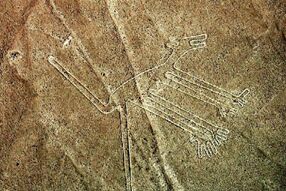人工智能帮助科学家在纳斯卡线条中发现新的人形地画
|
AI helps discover new geoglyph in the Nazca Lines 人工智能帮助科学家在纳斯卡线条中发现新的人形地画 Scientists from Japan have used machine learning for the first time to identify a new figure among the ancient motifs of Peru's Nazca Lines. 日本的科学家首次使用机器学习在秘鲁的纳斯卡线条的古代图案中发现了一幅新的人形地画。
The illustration, known as a geoglyph, is thought to date to between 100 BC and 500 AD, and was made by removing the dark stones of the Nazca Desert to reveal the white sand beneath. It's small, just five meters in height, and it shows a humanoid figure grasping a cane or club. Like the other drawings in the Nazca Desert, its exact function is unknown, but its discovery next to an ancient path suggests it might have been used as a waypoint. 据称,这一人形地画可以追溯到公元前100年至公元500年间。因为纳斯卡沙漠的深色石头被移开,露出了下面的白色沙子,才有了这一人形地画。该画很小,只有五米高,上面是一个抓着拐杖或棍棒的人形形象。与纳斯卡沙漠中的其它地画一样,目前尚不清楚该人形地画所起的确切作用。但科学家是在一条古老的小径旁发现的这一人形地画,这意味着它可能是一个路标。 "It's a large achievement." “这是一项重大进展。” "It is in an area that we often investigated, but we did not know the geoglyph existed," Professor Makato Sakai, the leader of a team from Yamagata University that conducted the research, told The Verge over email. "It's a large achievement." 日本山形大学的一个教授团队开展了这项研究,研究团队的负责人马凯特·酒井(Makato Sakai)教授在写给The Verge期刊的邮件中写道:“我们经常在该地区进行调查,但此前却并不知道它的存在。” The geoglyph was discovered during a larger research project by Yamagata University. Over a decade, using a combination of on-site surveying and aerial imagery, archeologists from the university manually identified 142 new designs in the desert. Then, working with researchers from IBM Japan, they used machine learning to scan the data for designs missed in earlier studies. This revealed geoglyph number 143, our fellow with the cane. It's the first design to be discovered with the help of artificial intelligence. 在山形大学开展的另一个较大的研究项目中,该人形地画得以发现。十多年来,该大学的考古学家结合现场勘测和航拍图像,在沙漠中识别了142种新设计。然后,他们与日本IBM公司的研究人员合作,使用机器学习扫描数据,以查找早期研究中遗漏的设计。因此就有了第143幅纳斯卡线条人形地画(也就是拄着拐杖的人形),这是研究人员在人工智能的帮助下发现的第一个设计。 The Nazca Lines occupy an area of roughly 19 square miles, and they are thought to have been made over many centuries starting around 100 BC by the Nazca people of modern-day Peru. They were first studied in detail in the 1940s, and by the time they were designated a UNESCO World Heritage Site in 1994, around 30 were identified. They're remarkably well-preserved considering their age, helped by the desert's dry climate and winds that sweep away the sand. 纳斯卡线条占地约19平方英里,据认为,它们是由生于现代秘鲁的纳斯卡人在公元前100年左右开始制作的。在20世纪40年代,研究员首次对它们进行了详细的研究。1994年被指定为联合国教科文组织世界遗产时,已确定了约30幅人形地画。虽年份久远,但这些线条保存良好,这主要得益于沙漠的干旱气候和吹走沙尘的风。 |









